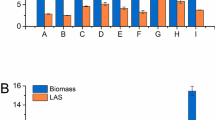Abstract
The microcolony technique enables the effects of several atmospheric conditions on fungal growth to be studied by measuring the radius of the colony, while excluding effects of those conditions on germination of the sporangiospores. Various concentrations of oxygen and carbon dioxide in the gas environment were found to influence growth ofRhizopus oligosporus on malt extract/soya peptone/agar. The maximum radial growth rate was 1.48 mm/h and the maximum specific growth rate was 0.109 h−1 at 30°C. Oxygen became limiting below 1% (v/v), but growth remained possible at levels of 0.001% oxygen. Carbon dioxide stimulated growth at limiting oxygen levels. The specific growth rate increased from 0.043 h−1 at 0.5% (v/v) oxygen and 0% (v/v) carbon dioxide to 0.096 h−1 at 0.5% (v/v) oxygen and 5% (v/v) carbon dioxide. A mixture of 0.5% (v/v) oxygen and 35% (v/v) carbon dioxide inhibited growth. Delay of sporangiospore germination due to low (less than 0.001%) amounts of oxygen was not observed with the techniques used. Fungal activity in a rotating drum fermentor was more strongly affected by low levels of oxygen than was biomass formation on model media. High concentrations of carbon dioxide inhibited growth in the rotating drum fermentor at non-limiting levels of oxygen. It is concluded that aeration and heat removal are both essential aspects of optimization of large-scale solid-substrate bioreactors withRh. oligosporus.
Similar content being viewed by others
References
Alvarez-Martinez LR (1987) Modeling fungalRhizopus oligosporus growth on extruded corn by solid substrate fermentation. PhD Thesis, Colorado State University (Diss. Abst. Int. B49, 1284)
Gadd GM (1988) Carbon utilization, In: Berry DR (ed) Physiology of industrial fungi. Blackwell, Oxford
Hesseltine CW, Featherston CL, Lombard GL, Dowell VR Jr (1985) Anaerobic growth of molds isolated from fermentation starters used for foods in Asian countries. Mycology 77:390–400
Mitchell DA, Lonsane BK (1992) Definition, characteristics and potential. In: Doelle HW (ed) Solid-substrate cultivation. Elsevier, Barking, England
Mitchell DA, Doelle HW, Greenfield PF (1988) Improvement of growth ofRhizopus oligosporus on a model solid substrate. Biotechnol Lett 10:497–502
Nout MJR, Rombouts FM (1990) Recent developments in tempe research. J Appl Bacteriol 69:609–633
Okazaki N, Sugama S, Tanaka (1980) Mathematical model for surface culture of koji mould. J Ferment Technol 58:471–476
Oriol E, Schettino B, Viniegra-González G, Raimbault M (1987) Solid-state culture ofAspergillus niger on support. J Ferment Technol 66:57–62
Paster N, Menasherov M (1985) Inhibition of T2 toxin production of high moisture corn kernels by modified atmospheres. Appl Environ Microbiol 54:540–543
Pirt SJ (1967) A kinetic study of the mode of growth of surface colonies of bacteria and Fungi. J Gen Microbiol 47:181–187
Rathbun BL, Shuler ML (1983) Heat and mass transfer effects in a static solid substrate fermentations: design of fermentation chambers. Biotechnol Bioeng 25:929–938
Reu JC de, Zwietering MH, Rombouts FM, Nout MJR (1993) Temperature control in solid substrate fermentation through discontinuous rotation. Appl Microbiol Biotechnol 40: 261–265
Seaby DA, McCracken AR, Blakeman JP (1988) Experimental determination of requirements for the growth of edibleRhizopus species for use in solid substrate fermentation. J Sci Food Agric 44:289–299
Soccol CR, Raimbault M, Pinheiro LI (1994) Effect of CO2 concentration on the mycelium growth ofRhizopus species. Arq Biol Technol (Curitiba) 37:203–210
Trinci APJ (1969) A kinetic study of the growth ofAspergillus nidulans and other fungi. J Gen Microbiol 57:11–24
Trinci APJ (1971) Influences of the width of the peripheral growth zone on the radial growth rate of fungal colonies on solid medium. J Gen Microbiol 67:325–344
Wells JM, Uota M (1969) Germination and growth of five fungi in low oxygen and high carbon dioxide atmosphere. Plant Pathol Hort 60:50–53
Author information
Authors and Affiliations
Rights and permissions
About this article
Cite this article
de Reu, J.C., Griffiths, A.M., Rombouts, F.M. et al. Effect of oxygen and carbon dioxide on germination and growth ofRhizopus oligosporus on model media and soya beans. Appl Microbiol Biotechnol 43, 908–913 (1995). https://doi.org/10.1007/BF02431927
Received:
Revised:
Accepted:
Issue Date:
DOI: https://doi.org/10.1007/BF02431927




